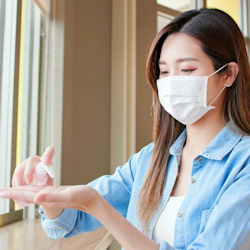Preventing Exposure
Introduction
This module discusses how to eliminate and reduce exposure to salon hazards primarily through safe work practices, respiratory protection, and adequate ventilation.
The Toxic Trio
Eliminate the Hazard
The first priority in reducing exposure to chemical hazards in the nail salon is accomplished by eliminating the hazardous chemicals. After all, if you don't have the hazardous chemical, you can't be exposed to it.
Whenever possible, use products with the least hazardous chemicals in them.
- 3- and 5-free products: Some products now claim to be 3-free ( no toluene, formaldehyde, and dibutyl phthalate), or 5-free (3-free + no formaldehyde resin and camphor).
- Acid free products: Some primers claim to be made without chemicals like methacrylic acid. These are labeled "acid free."
Nail polish brands can have up to 30 chemicals that are not regulated by the FDA. Always read product labels and Safety Data Sheets (SDSs). Always follow manufacturer instructions when using all nail salon products, including those labeled as "free" of hazardous chemicals.
Proper disposal is another way to eliminate chemical hazards. Some chemicals must be disposed of in a specific way. For example, used liquid acetone must be saved in a fire department approved metal container and disposed of as hazardous waste.
Avoid Contact

Use the following best practices to keep hazardous products off your skin and out of your eyes.
- Wear long-sleeved shirts to protect your arms and pants or skirts that are at least knee-length to protect your lap from acrylic nail and other dusts.
- Wash your hands before and after working on clients; before eating, drinking, putting on cosmetics or smoking; and after handling or transferring products.
- Wear goggles and the appropriate type of disposable gloves when handling and transferring products. For example, nitrile gloves (usually blue or purple) protect against many chemicals used in nail salon products, but latex or vinyl gloves are appropriate when handling acetone.
- Replace gloves immediately if there are cuts, tears, or holes in them.
- Cover and protect cuts or cracks in your skin. Damaged skin can increase chemical absorption and exposure.
- Do not continue to use a product if you see signs of skin irritation.
Knowledge Check Choose the best answer for the question.
2-1. Materials containing used liquid acetone must be disposed of _____.
You forgot to answer the question!
